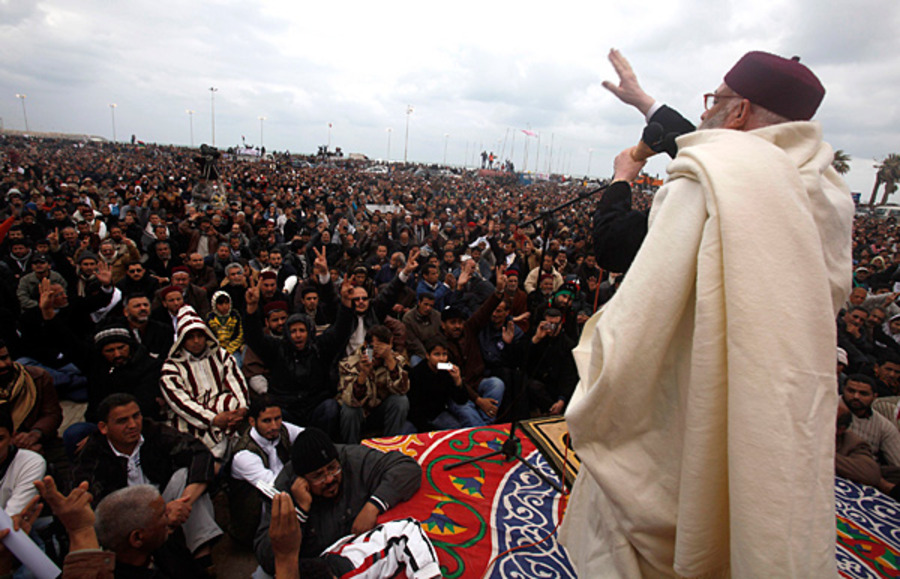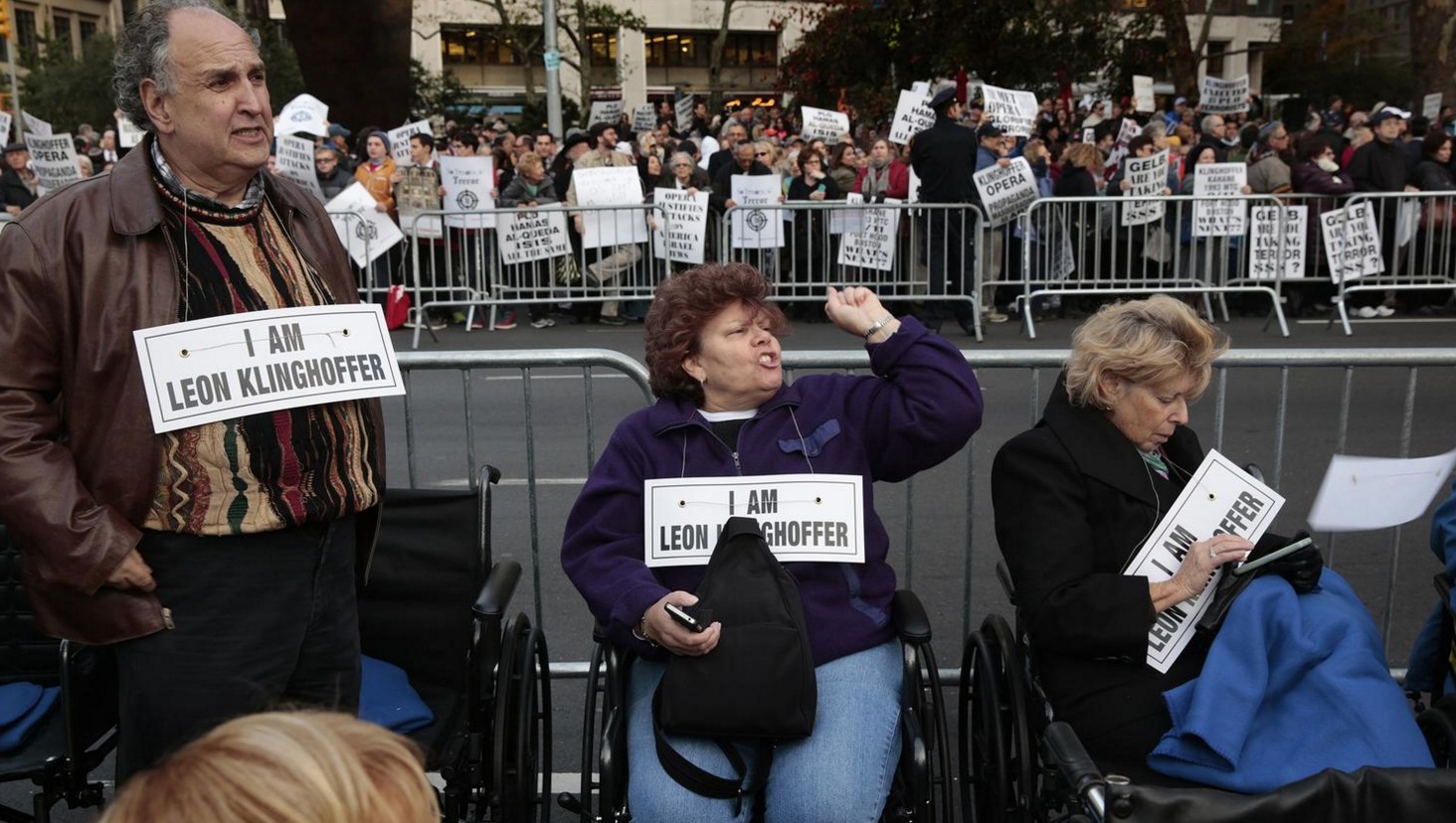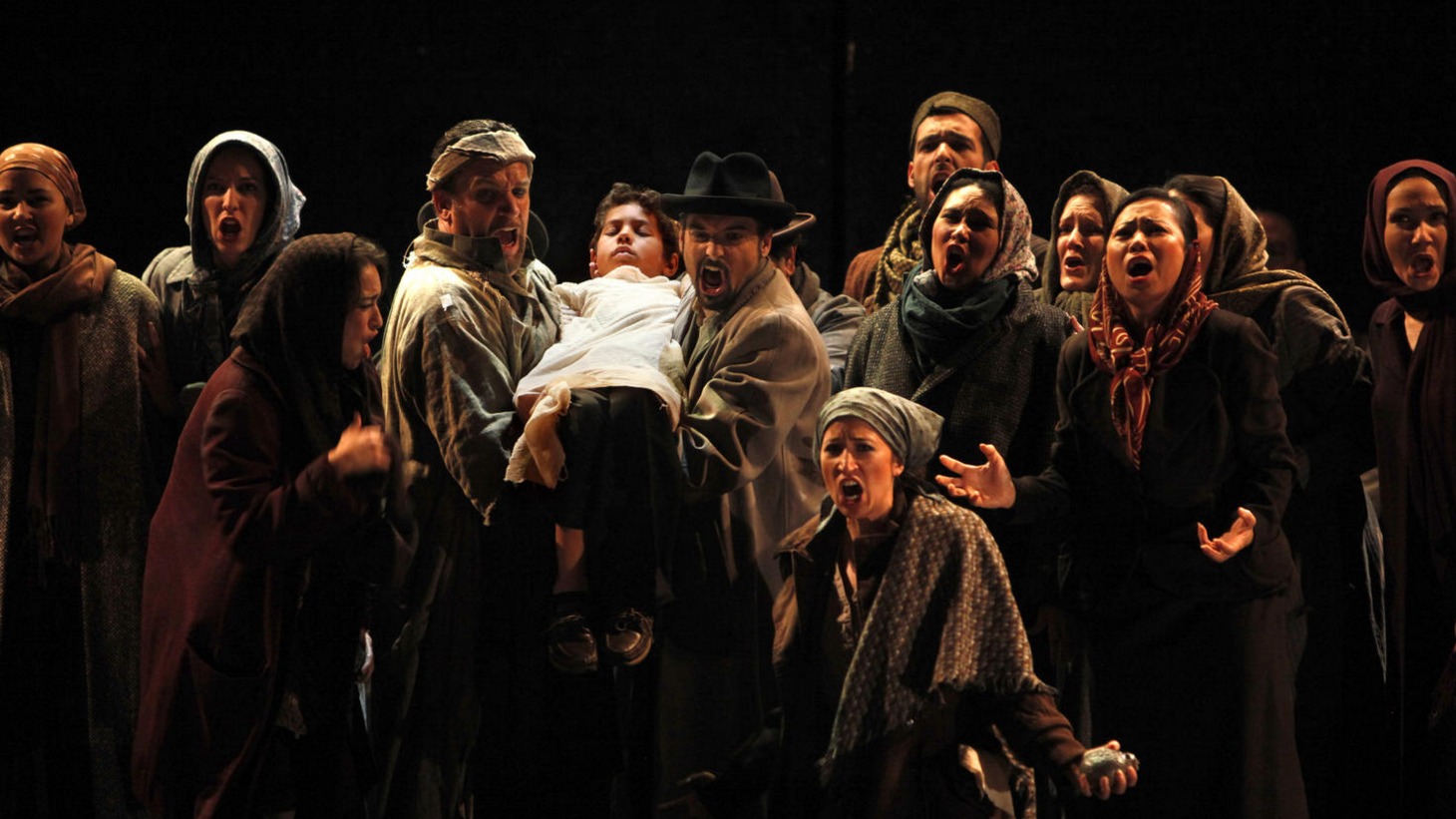The Libyan Uprising Photo Gallery, 2911, The Christian Science Monitor,

Libya uprising
Image 23 / 30 : The burned-out People's Hall, the main building for government gatherings where the country's equivalent of a parliament holds sessions several times a year, stands in Tripoli, Libya, on Feb. 21. AP

Libya uprising
Image 15 / 30 : Antigovernment demonstrators listen to a Friday prayers speech in Benghazi on Feb. 25. Libya's rebellious city of Benghazi has filled a political void with a coalition which is cleaning up, providing food, building defenses, reassuring foreign oil firms, and telling Tripoli it believes in one nation. The city paid a high price for the revolt with up to 250 dead. Asmaa Waguih/Reuters

Libya uprising
Image 11 / 30 : Libyan anti-government protesters, some carrying monarchist-era flags, chant slogans as they demonstrate against Libyan leader Muammar Qaddafi in Nalut, Libya, on March 1. The town is currently in control of the Libyan anti-government forces. Lefteris Pitarakis/AP

Libya uprising
Image 7 / 30 : An anti-Qaddafi rebel holds his antiaircraft missile in the oil town of Ras Lanouf, Libya, on March 6. Hussein Malla/AP

Libya uprising
Image 20 / 30 : Protesters riding in the back of a vehicle display the victory sign in Benghazi, Libya, on Feb. 21. Libyan protesters celebrated claiming control of the country's second largest city after bloody fighting and antigovernment unrest spread to Tripoli. Alaguri/AP

Libya uprising
Image 5 / 30 : Anti-Qaddafi rebels pray at a checkpoint at Ras Lanuf, Libya, on March 10. The rebel leadership said that the oil port of Ras Lanuf in eastern Libya is under heavy bombardment. Asmaa Waguih/Reuters

Libya uprising
Image 3 / 30 : Students chant anti-Qaddafi slogans during a demonstration in Benghazi, Libya, on March 13. Hundreds of students took to the streets protesting what they called the Libyan leader's war crimes and demanding that the international community impose a no-fly zone over Libya. Nasser Nasser/AP


Libya uprising
Image 16 / 30 : On Feb. 25, mourners carry coffins containing the bodies of Libyans who were killed in the recent clashes in Benghazi. Suhaib Salem/Reuters

Libya uprising
Image 15 / 30 : Antigovernment demonstrators listen to a Friday prayers speech in Benghazi on Feb. 25. Libya's rebellious city of Benghazi has filled a political void with a coalition which is cleaning up, providing food, building defenses, reassuring foreign oil firms, and telling Tripoli it believes in one nation. The city paid a high price for the revolt with up to 250 dead. Asmaa Waguih/Reuters

Libya uprising
Image 12 / 30 : Unidentified pro-Qaddafi security forces stand near a checkpoint on a street in Qasr Banashir, Libya, on March 1. Government opponents in rebel-held Zawiya repelled an attempt by forces loyal to Muammar Qaddafi to retake the city closest to the capital in six hours of fighting overnight, witnesses said. Ben Curtis/AP

Libya uprising
Image 8 / 30 : A rebel fighter fires his rifle at a military aircraft loyal to Qaddafi at a checkpoint in Ras Lanouf, Libya, on March 7. Goran Tomasevic/Reuters

Libya uprising
Image 6 / 30 : Two Libyan rebels load an antiaircraft gun cartridge by the entrance of Ras Lanuf, Libya, on March 10. Qaddafi's forces pushed rebel fighters from the strategic oil port of Ras Lanuf on March 10, driving the opposition from the city with a withering rain of artillery fire. Nasser Nasser/AP

Libya uprising
Image 4 / 30 : Pro-Qaddafi fighters raise their fists in victory during a government-organized visit for foreign media near Ras Lanuf, Libya, on March 12. The world moved closer to a decision on imposing a no-fly zone over Libya while Qaddafi advanced on the poorly equipped and loosely organized rebels who have seized much of the country. Ben Curtis/AP

Libya uprising
Image 21 / 30 : Protesters stand on a tank holding a pre-Qaddafi era national flag inside a security forces compound in Benghazi, Libya, on Feb. 21. Alaguri / AP

Libya uprising
Image 2 / 30 : Two Libyan rebels check two Libyan passengers riding in a vehicle that is crossing toward Egypt near the border town of Musaed, Libya, on March 16.














December 24, 2015, The Christian Science Monitor, 200 Islamic extremist fighters split from rebels, pledge allegiance to IS, by Tom Odula, Associated Press,

An armed member of the militant group Al Shabab attends a rally in support of the merger of the Somali militant group Al Shabab with Al Qaeda, on the outskirts of Mogadishu, Somalia, in 2012. The defections of two American Islamic extremist fighters in Somalia highlight tensions within the insurgent group Al Shabab over whether it should remain affiliated to Al Qaeda or switch allegiance to the Islamic State group, according to an AlSShabab commander Dec. 8, 2015.
NAIROBI, KENYA — About 200 Islamic extremist fighters have split from Somalia's Al Shabab rebels, who are allied to Al Qaeda, and have instead pledged allegiance to the Islamic State group, Kenya's police chief said Thursday.
The splinter group is operating around the Somali border in Kenya's north, and has carried out at least two attacks in the last two weeks, killing one soldier and two civilians in Mandera County, Joseph Boinett told the Associated Press.The split in Al Shabab poses an extra challenge for Kenya's security forces, Mr. Boinnet said. Among those who have joined the pro-IS faction of Al Shabab is Mohamed Kuno, alias Gamadhere, who is wanted for the April 2 attack by Al Shabab gunmen on Kenya's Garissa University in the country's east, in which 148 people were killed, Boinnet said.
Recommended: Kenya: Amid fear and flight, a Muslim minority embraces self-sufficiency
Al Shabab has vowed retribution on Kenya for sending troops to Somalia to fight the Islamic extremists. Kenya has experienced a series of Al Shabab attacks since it sent its troops to Somalia in 2011.
The defections are causing tensions within Al Shabab.
Two men, an American citizen and U.S. resident, defected from Al Shabab and surrendered to Somali authorities earlier this month fearing they would be killed by their former colleagues on suspicion that they are IS supporters. Al Qaeda and Islamic State are rivals for jihadi recruits.

Libya uprising
Image 17 / 30 : Gunmen prepared to fight against Libyan leader Muammar Qaddafi stand on a small military truck with weapons taken from a Libyan military base, in Benghazi, Libya, on Feb. 24. Hussein Malla/AP

Libya uprising
Image 13 / 30 : A pro-Qaddafi Libyan soldier sits in an armored vehicle next to a mosque in Qasr Banashir, Libya, on March 1. Ben Curtis/AP

Libya uprising
Image 9 / 30 : Anti-Qaddafi rebels fire multiple rockets during a battle against pro-Qaddafi fighters near the town of Bin-Jawad, Libya, on March 6. Hussein Malla/AP

Libya uprising
Image 22 / 30 : On Feb. 22 in Benghazi, Libya, a placard shows photos of some of those who have died in Libyan antigovernment protests. Alaguri/AP

Libya uprising
Image 18 / 30 : On Feb. 25, protesters against Libyan leader Muammar Qaddafi pray next to coffins containing the bodies of Libyans who were killed in the recent clashes. Suhaib Salem/Reuters

Libya uprising
Image 14 / 30 : Bangladeshi workers who have been trying to leave Libya for more than six days wake up in the morning in a makeshift tent as they wait to be evacuated in Benghazi, Libya, on March 1. Tara Todras-Whitehill/AP

Libya uprising
Image 10 / 30 : Smoke rises following an air strike by Libyan warplanes near the anti-Qaddafi rebels' checkpoint in Ras Lanouf, Libya, on March 7. Libyan rebels say they are regrouping after forces loyal to Qaddafi pounded opposition fighters with helicopter gunships, artillery, and rockets to stop the rebels' rapid advance toward the capital. Hussein Malla/AP

Libya uprising
Image 19 / 30 : Egyptians who used to work in Libya and fled the unrest in the country wait for their breakfast in a makeshift refugee camp set up by the Tunisian Army at the Tunisia-Libyan border in Ras Ajdir, Tunisia, on Feb. 25. Lefteris Pitarakis/AP

Libya uprising
Image 24 / 30 : Antigovernment protesters demonstrate in Tripoli, Libya, on Feb. 22 in this image taken from television. APTN/AP

Libya uprising
Image 25 / 30 : Buildings burn at the entrance to a security forces compound in Benghazi, Libya, on Feb. 21. Alaguri/AP

Libya uprising
Image 26 / 30 : A girl perched in a car window displays the victory sign in Benghazi, Libya, on Feb. 21. Alaguri/AP

Libya uprising
Image 27 / 30 : A protester stands on top of a burned guard post at the entrance to a security forces compound in Benghazi, Libya, on Feb. 21. Alaguri/AP

Libya uprising
Image 28 / 30 : An army soldier and antiregime protesters pose for photos in front of a tank in the early hours of Feb. 22 in Benghazi, Libya. Alaguri/AP

Libya uprising
Image 29 / 30 : This image was taken from a broadcast on Libyan state television on Feb. 22. Libyan leader Muammar Qaddafi appeared for less than a minute to say that he was in Tripoli and to deny rumors he had fled to Venezuela amid the unrest sweeping his country. Libyan State Television/AP
________________________________________________________________________________
December 24, 2015, The Christian Science Monitor, 200 Islamic extremist fighters split from rebels, pledge allegiance to IS, by Tom Odula, Associated Press,
AFRICA200 Islamic extremist fighters split from rebels, pledge allegiance to IS,
About 200 Islamic extremist fighters have split from Somalia's Al Shabab rebels, who are allied to Al Qaeda, and have instead pledged allegiance to the Islamic State group, Kenya's police chief saidThursday.

An armed member of the militant group Al Shabab attends a rally in support of the merger of the Somali militant group Al Shabab with Al Qaeda, on the outskirts of Mogadishu, Somalia, in 2012. The defections of two American Islamic extremist fighters in Somalia highlight tensions within the insurgent group Al Shabab over whether it should remain affiliated to Al Qaeda or switch allegiance to the Islamic State group, according to an AlSShabab commander Dec. 8, 2015.
NAIROBI, KENYA — About 200 Islamic extremist fighters have split from Somalia's Al Shabab rebels, who are allied to Al Qaeda, and have instead pledged allegiance to the Islamic State group, Kenya's police chief said Thursday.
The splinter group is operating around the Somali border in Kenya's north, and has carried out at least two attacks in the last two weeks, killing one soldier and two civilians in Mandera County, Joseph Boinett told the Associated Press.The split in Al Shabab poses an extra challenge for Kenya's security forces, Mr. Boinnet said. Among those who have joined the pro-IS faction of Al Shabab is Mohamed Kuno, alias Gamadhere, who is wanted for the April 2 attack by Al Shabab gunmen on Kenya's Garissa University in the country's east, in which 148 people were killed, Boinnet said.
Recommended: Kenya: Amid fear and flight, a Muslim minority embraces self-sufficiency
Al Shabab has vowed retribution on Kenya for sending troops to Somalia to fight the Islamic extremists. Kenya has experienced a series of Al Shabab attacks since it sent its troops to Somalia in 2011.
The defections are causing tensions within Al Shabab.
Two men, an American citizen and U.S. resident, defected from Al Shabab and surrendered to Somali authorities earlier this month fearing they would be killed by their former colleagues on suspicion that they are IS supporters. Al Qaeda and Islamic State are rivals for jihadi recruits.
In October, Nigeria's Boko Haram extremists urged Al Shabab rebels to join them in pledging allegiance to the Islamic State group and thus abandon Al Qaeda.
The appeal from an unidentified armed fighter is part of a wider courting of Al Shabab. Similar messages came nearly two weeks ago from militant extremists in Iraq, Sinai, Syria, and Yemen.
The appeal from an unidentified armed fighter is part of a wider courting of Al Shabab. Similar messages came nearly two weeks ago from militant extremists in Iraq, Sinai, Syria, and Yemen.





























